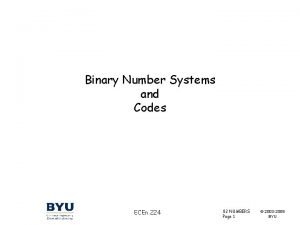COP 4610 L Applications in the Enterprise Spring





































![public static void main(String[] args) { Calendar c = Calendar. get. Instance(); c. set(Calendar. public static void main(String[] args) { Calendar c = Calendar. get. Instance(); c. set(Calendar.](https://slidetodoc.com/presentation_image_h2/75fd4d9eb41487eae2f62eba7c86f6f4/image-38.jpg)























- Slides: 61

COP 4610 L: Applications in the Enterprise Spring 2006 Programming Multithreaded Applications in Java Part 1 Instructor : Dr. Mark Llewellyn markl@cs. ucf. edu CSB 242, 823 -2790 http: //www. cs. ucf. edu/courses/cop 4610 L/spr 2006 School of Electrical Engineering and Computer Science University of Central Florida COP 4610 L: Threading Part 1 Page 1 Mark Llewellyn ©

Introduction to Threads in Java • In state-of-the art software, a program can be composed of multiple independent flows of control. • A flow of control is more commonly referred to as a process or thread. • In most of the Java programs that you’ve written (probably) there was a single flow of control. Most console-based programs begin with the first statement of the method main() and work forward to the last statement of the method main(). Flow of control is often temporarily passed to other methods through invocations, but the control returned to main() after their completion. • Programs with a single control flow are known as sequential processes. COP 4610 L: Threading Part 1 Page 2 Mark Llewellyn ©

Introduction to Threads in Java (cont. ) • Java supports the creation of programs with concurrent flows of control. These independent flows of control are called threads. • Threads run within a program and make use of that program’s resources in their execution. For this reason threads are also called lightweight processes (LWP). • The ability to run more than one process simultaneously is an important characteristic of modern OS such as Linux/Unix and Windows. – The following two pages show screen shots of a set of applications running on my office PC as well as the set of OS and applications processes required to run those applications. COP 4610 L: Threading Part 1 Page 3 Mark Llewellyn ©

Applications running on my office PC COP 4610 L: Threading Part 1 Page 4 Mark Llewellyn ©

Some of the processes running the applications running on my office PC CPU working hard!!! COP 4610 L: Threading Part 1 Page 5 Mark Llewellyn ©

Using Threads To Improve Performance One Thread Task 1 Wait for I/O Thread 1 Task 1 Wait for I/O Thread 2 (Idle) Task 2 (Idle) Thread 1 Task 2 Time Two Threads Task 2 Time COP 4610 L: Threading Part 1 Page 6 Mark Llewellyn ©

Improving Performance With Multithreading • As the diagram on the previous page implies, applications that perform several tasks which are not dependent on one another will benefit the most from multithreading. • For example, in the previous diagram, Task 2 can only be overlapped with Task 1 if Task 2 doesn’t depend on the results of Task 1. • However, some overlap between the two tasks may still be possible even if Task 2 depends on the results of Task 1. In this case the two tasks must communicate so that they can coordinate their operations. COP 4610 L: Threading Part 1 Page 7 Mark Llewellyn ©

Improving Performance With Multithreading (cont. ) • Writing multithreaded programs can be tricky and complicated, particularly when synchronization between threads is required. • Although the human mind can perform many functions concurrently, people find it difficult to jump between parallel trains of thought. • To see why multithreading can be difficult to program and understand, try the experiment shown on the following page. COP 4610 L: Threading Part 1 Page 8 Mark Llewellyn ©

Multithreading Experiment In this chapter, we introduce Swing components that enable developers to build functionally rich user interfaces. Page 1 The Swing graphical interface components were introduced with the Java Foundation Classes (JFC) as a downloadable extension to the Java 1. 1 Platform, then became a standard extension with the Java 2 Platform. Page 2 Swing provides a more complete set of GUI components than the Abstract Windowing Toolkit (AWT), including advanced features such as a pluggable look and feel, lightweight component rendering and drag-and-drop capabilities. The experiment: Try reading the pages above concurrently by reading a few words from the first page, then a few words from the second page, then a few words from the third page, then loop back and read a few words from the first page, and so on. Does anything make sense? Can you construct a single sentence from what you have read? Can you remember on which page a particular word appeared? Can you even remember when you get back to the first page where you left off? COP 4610 L: Threading Part 1 Page 9 Page 3 Mark Llewellyn ©

Typical Multithreaded Applications • Used to improve the performance of applications which require extensive I/O operations. • Useful in improving the responsiveness of GUI-based applications. • Used when two or more clients need to run server-based applications simultaneously. Note: on a single CPU machine, threads don’t actually execute simultaneously. Part of the JVM known as the thread scheduler time-slices threads which are runnable (we’ll see more of this in a bit) giving the illusion of simultaneous execution. COP 4610 L: Threading Part 1 Page 10 Mark Llewellyn ©

This statement starts thread A. After starting thread A, the program continues with the next statement. Thread A { A statement 1; A statement 2; … A statement m; … A statement n; } This statement in thread A starts thread C. Thread A continues with next statement. COP 4610 L: Threading Part 1 Multithreaded Program { statement 1; statement 2; … statement x; … statement y; … statement z; } Thread C { C statement 1; C statement 2; … C statement t; } Page 11 A multithreaded program ends when all of its individual flows of control (threads) end. This statement starts thread B. After starting the thread, the program continues with the next statement. Thread B { B statement 1; B statement 2; … statement r; } Mark Llewellyn ©

Thread A Thread B Thread C Thread Execution in a Multiprocessor Environment Thread A Thread B Thread C Thread Execution in a Uniprocessor Environment COP 4610 L: Threading Part 1 Page 12 Mark Llewellyn ©

The Java Thread Class java. lang. Runnable Creates a default thread. Creates a new thread to run the target object java. lang. Thread +Thread() +Thread (target: Runnable) +run(): void Invoked by the JVM to execute thread. You must override this method and provide the code you want your thread to execute in your thread class. This method is never directly invoked by a the runnable object in a program, although it is an instance method of a runnable object. Starts the thread that causes the run() method to be invoked by the JVM +start(): void +interrupt(): void +is. Alive(): boolean +set. Priority(p: int): void +join(): void +sleep(millis: long): void +yield(): void +is. Interrupted(): boolean +current. Thread(): Thread Interrupts this thread. If the thread is blocked, it is ready to run again. Tests if the thread is currently running. Sets priority p (ranging from 1 to 10) for this thread. Waits for this thread to finish. Puts the runnable object to sleep for a specified time in milliseconds. Causes this thread to temporarily pause and allow other threads to execute Tests if the current thread has been interrupted Returns a reference to the currently executing thread object. COP 4610 L: Threading Part 1 Page 13 Mark Llewellyn ©

Java Classes and Threads • Java has several classes that support the creation and scheduling of threads. • The two basic ways of creating threads in Java are: – 1) extending the Thread class – or 2) implementing the Runnable interface. (Both are found in package java. lang. Thread actually implements Runnable. ) • We’ll also look at a slightly different technique for creating and scheduling threads later using the java. util. Timer and java. util. Timer. Task classes. COP 4610 L: Threading Part 1 Page 14 Mark Llewellyn ©

Java Classes and Threads (cont. ) • The following two simple examples, illustrate the differences in creating threads using these two different techniques. • The example is simple, three threads are created, one that prints the character ‘A’ twenty times, one that prints the character ‘B’ twenty times, and a third thread that prints the integer numbers from 1 to 20. • The first program is an example of extending the thread class. The second program is an example of using the Runnable interface. This latter technique is the more common and preferred technique. While we will see more examples of this technique later, this simple example will illustrate the difference in the two techniques. COP 4610 L: Threading Part 1 Page 15 Mark Llewellyn ©

//Client Class to utilize Custom. Thread Public class Client {… public void some. Method( ) { … //create a thread Custom. Thread thread 1 = new Custom. Thread(…); //start a thread 1. start( ); … //Custom Thread Class Public class Custom. Thread extends Thread {… public Custom. Thread(…) { … } //Override the run method in Thread //Tell system how to run custom thread public void run( ) { … } //end Custom. Thread Class //create another thread Custom. Thread thread 2 = new Custom. Thread(…); //start another thread 2. start( ); … Template for defining a thread class by extending the Thread class. Threads thread 1 and thread 2 are runnable objects created from the Custom. Thread class. The start method informs the system that the thread is ready to run. COP 4610 L: Threading Part 1 } … } //end Client Class Page 16 Mark Llewellyn ©

//Custom Thread Class Public class Custom. Thread implements Runnable {… public Custom. Thread(…) { … } //Implement the run method in Runnable //Tell system how to run custom thread public void run( ) { … } //end Custom. Thread Class Template for defining a thread class by implementing the Runnable interface. To start a new thread with the Runnable interface, you must first create an instance of the class that implements the Runnable interface (in this case custhread), then use the Thread class constructor to construct a thread. COP 4610 L: Threading Part 1 //Client Class to utilize Custom. Thread Public class Client {… public void some. Method( ) { … //create an instance of Custom. Thread custhread = new Custom. Thread(…); … //create a thread Thread thread = new. Thread(custhread); … //start a thread. start( ); … } //end Client Class Page 17 Mark Llewellyn ©

//Class to generate threads by extending the Thread class public class Test. Thread { // Main method public static void main(String[] args) { // Create threads Print. Char print. A = new Print. Char('a', 20); Print. Char print. B = new Print. Char('b', 20); Print. Num print 20 = new Print. Num(20); Start thread execution after a 0 msec delay (i. e. , immediately) // Start threads print 20. start(); print. A. start(); print. B. start(); } } // The thread class for printing a specified character a specified number of times class Print. Char extends Thread { Extension of the Thread private char. To. Print; // The character to print class private int times; // The times to repeat // Construct a thread with specified character and number of times to print the character public Print. Char(char c, int t) { char. To. Print = c; times = t; } COP 4610 L: Threading Part 1 Page 18 Mark Llewellyn ©

// Override the run() method to tell the system what the thread will do public void run() { for (int i = 0; i < times; i++) System. out. print(char. To. Print); } } // The thread class for printing number from 1 to n for a given n class Print. Num extends Thread { private int last. Num; // Construct a thread for print 1, 2, . . . i public Print. Num(int n) { last. Num = n; } Overriding the run method in the Thread class // Tell the thread how to run public void run() { for (int i = 1; i <= last. Num; i++) System. out. print(" " + i); } } //end class Test. Thread COP 4610 L: Threading Part 1 Page 19 Mark Llewellyn ©

Sample executions of class Test. Thread. Notice that the output from the threads is interleaved. Also notice that the output sequence is not repeatable. COP 4610 L: Threading Part 1 Page 20 Mark Llewellyn ©

//Class to generate threads by implementing the Runnable interface public class Test. Runnable { // Create threads Thread print. A = new Thread(new Print. Char('a', 20)); Thread print. B = new Thread(new Print. Char('b', 20)); Thread print 20 = new Thread(new Print. Num(20)); Main method simple creates a new Runnable object and terminates. public static void main(String[] args) { new Test. Runnable(); } public Test. Runnable() { // Start threads print 20. start(); print. A. start(); print. B. start(); } Runnable object starts thread execution. // The thread class for printing a specified character in specified times class Print. Char implements Runnable { private char. To. Print; // The character to print private int times; // The times to repeat Implements the Runnable interface. // Construct a thread with specified character and number of times to print the character public Print. Char(char c, int t) { char. To. Print = c; times = t; } COP 4610 L: Threading Part 1 Page 21 Mark Llewellyn ©

// Override the run() method to tell the system what the thread will do public void run() { for (int i = 0; i < times; i++) System. out. print(char. To. Print); } } // The thread class for printing number from 1 to n for a given n class Print. Num implements Runnable { private int last. Num; // Construct a thread for print 1, 2, . . . i public Print. Num(int n) { last. Num = n; } Override the run method for both types of threads. // Tell the thread how to run public void run() { for (int i = 1; i <= last. Num; i++) System. out. print(" " + i); } } } //end class Test. Runnable COP 4610 L: Threading Part 1 Page 22 Mark Llewellyn ©

Sample executions of class Test. Runnable. Notice that the output from the threads is interleaved. Also notice that the output sequence is not repeatable. COP 4610 L: Threading Part 1 Page 23 Mark Llewellyn ©

Some Modifications to the Example • To illustrate some of the methods in the Thread class, you might want to try a few modifications to the Test. Runnable class in the previous example. Notice how the modifications change the order of the numbers and characters in the output. • Use the yield() method to temporarily release time for other threads to execute. Modify the code in the run method in Print. Num class to the following: public void run() { for (int i = 1; i <= last. Num; i++) { System. out. print(" " + i); Thread. yield(); } – Now every time a number is printed, the print 20 thread yields, so each number will be followed by some characters. COP 4610 L: Threading Part 1 Page 24 Mark Llewellyn ©

Some Modifications to the Example (cont. ) • The sleep(long millis) method puts the thread to sleep for the specified time in milliseconds. Modify the code in the run method in Print. Num class to the following: public void run() { for (int i = 1; i <= last. Num; i++) { System. out. print(" " + i); try { if (i >= 10) Thread. sleep(2); } catch (Interrupted. Exception ex) { } } } – Now every time a number greater than 10 is printed, the print 20 thread is put to sleep for 2 milliseconds, so all the characters will complete printing before the last integer is printed. COP 4610 L: Threading Part 1 Page 25 Mark Llewellyn ©

Some Modifications to the Example (cont. ) • You can use the join() method to force one thread to wait for another thread to finish. Modify the code in the run method in Print. Num class to the following: public void run() { for (int i = 1; i <= last. Num; i++) { System. out. print(" " + i); try { if (i == 10) print. A. join(); } catch (Interrupted. Exception ex) { } } } – Now the numbers greater than 10 are printed only after thread print. A is finished. COP 4610 L: Threading Part 1 Page 26 Mark Llewellyn ©

Other Java Classes and Threads • We noted earlier that Java has several different classes that support the creation and scheduling of threads. Classes java. util. Timer and java. util. Timer. Task are generally the easiest to use. They allow a thread to be created and run either at a time relative to the current time or at some specific time. • We’ll look at these classes briefly and give a couple of examples. COP 4610 L: Threading Part 1 Page 27 Mark Llewellyn ©

Java Classes and Threads • Class Timer overloads the schedule() method three times for creating threads after either some specified delay or at some specific time. – public void schedule(Timer. Task task, long m); • – – Runs task. run() after waiting m milliseconds. public void schedule(Timer. Task task, long m, long n); • Runs task. run() after waiting m milliseconds, then repeats it every n milliseconds. Public void schedule(Timer. Task task, Date t); • • (cont. ) Runs task. run() at the time indicated by date t. By extending the abstract class Timer. Task and specifying a definition for its abstract method run(), an applicationspecific thread can be created. COP 4610 L: Threading Part 1 Page 28 Mark Llewellyn ©

Example – Thread Execution After a Delay • The code listing on the following page gives a very simple example of executing a thread after a delay (using the first schedule() method from the previous page). • The thread in this example, simply prints a character 10 times and then ends. • Look at the code and follow the flow, then execute it on your machine (code appears on the course webpage). COP 4610 L: Threading Part 1 Page 29 Mark Llewellyn ©

//displays characters in separate threads import java. util. *; public class Display. Char. Sequence extends Timer. Task { private char display. Char; Timer timer; //constructor for character displayer public Display. Char. Sequence(char c){ display. Char = c; timer = new Timer(); timer. schedule(this, 0); } //display the occurrences of the character public void run() { for (int i = 0; i < 10; ++i) { System. out. print(display. Char); } timer. cancel(); } } Start thread execution after a 0 msec delay (i. e. , immediately) A subclass implementation of Timer. Task’s abstract method run() has typically two parts – first part is application specific (what the thread is supposed to do) and the second part ends the thread. //main public static void main (String[] args) { Display. Char. Sequence s 1 = new Display. Char. Sequence(‘M’); Display. Char. Sequence s 2 = new Display. Char. Sequence(‘A’); Display. Char. Sequence s 3 = new Display. Char. Sequence(‘R’); Display. Char. Sequence s 4 = new Display. Char. Sequence(‘K’); } COP 4610 L: Threading Part 1 Page 30 Mark Llewellyn ©

COP 4610 L: Threading Part 1 Page 31 Mark Llewellyn ©

Example – Repeated Thread Execution • This next example demonstrates how to schedule a thread to run multiple times. Basically, the thread updates a GUIbased clock every second. Sample GUI COP 4610 L: Threading Part 1 Page 32 Mark Llewellyn ©

//displays current time – threaded execution import java. util. *; import javax. swing. JFrame; import java. text. *; import java. awt. *; public class Basic. Clock extends Timer. Task { final static long MILLISECONDS_PER_SECOND = 1000; private JFrame window = new JFrame(“Basic Clock”); private Timer timer = new Timer(); private String clock. Face = “”; Two tasks: (1) configure the GUI and (2) schedule thread to update the GUI-clock every second. //constructor for clock public Basic. Clock(){ //set up GUI window. set. Default. Close. Operation(JFrame. EXIT_ON_CLOSE); window. set. Size(200, 60); Container c = window. get. Content. Pane(); c. set. Background(Color. WHITE); window. set. Visible(true); //update GUI every second beginning immediately timer. schedule(this, 0, 1*MILLISECONDS_PER_SECOND); } This form of the overloaded schedule() method is the second one shown on page 8 which uses a delay and a repetition factor. COP 4610 L: Threading Part 1 Page 33 Mark Llewellyn ©

Date() returns current time to the millisecond. to. String() method returns a textual representation of the date in the form: w c d h: m: s z y Where: w: 3 char-rep of day of week c: 3 char-rep of month d: 2 digit-rep of day of month h: 2 digit-rep of hour m: 2 digit-rep of minute within hr s: 2 digit-rep of second within min z: 3 char-rep of time zone y: 4 char-rep of year } } //display updated clock public void run(){ Date time = new Date(); Graphics g = window. get. Content. Pane(). get. Graphics(); g. set. Color(Color. WHITE); g. draw. String(clock. Face, 10, 20); clock. Face = time. to. String(); g. set. Color(Color. BLUE); g. draw. String(clock. Face, 10, 20); //main public static void main (String[] args) { Basic. Clock clock = new Basic. Clock(); } COP 4610 L: Threading Part 1 Page 34 Mark Llewellyn ©

!! CAUTION !! • Java provides two different standard classes named Timer. The class we’ve used in the past two examples is part of the util API. There is also a Timer class that is part of the swing API. • In our previous example, we needed to make sure that we didn’t inadvertently bring both Timer classes into our program which would have created an ambiguity about which Timer class was being used. • Although you cannot import both Timer classes into a single Java source file, you can use both Timer classes in the same Java source file. An import statement exists to allow a syntactic shorthand when using Java resources; i. e. , an import statement is not required to make use of Java resources. Using fully qualified class names will remove the ambiguity. – java. util. Time t 1 = new java. util. Timer(); – javax. swing. Timer t 2 = new javax swing. Timer(); COP 4610 L: Threading Part 1 Page 35 Mark Llewellyn ©

Example – Thread Execution At Specific Time • This next example demonstrates how to schedule a thread to run at a specific time. This example will create a couple of threads to remind you of impending appointments. Basically, the thread pops-up a window to remind you of the appointment. Sample Display. Alert Window COP 4610 L: Threading Part 1 Page 36 Mark Llewellyn ©

//Displays an alert at a specific time - threaded execution import javax. swing. JOption. Pane; import java. awt. *; import java. util. *; public class Display. Alert extends Timer. Task { //instance variables private String message; private Timer timer; //constructor public Display. Alert(String s, Date t){ message = s + ": " + t; timer = new Timer(); timer. schedule(this, t); } Third version of schedule() method as shown on page 28. //execute thread public void run() { JOption. Pane. show. Message. Dialog(null, message, “Mark’s Message Service”, JOPtion. Pane. INFORMATION_MESSAGE); //application specific task timer. cancel(); //kill thread } COP 4610 L: Threading Part 1 Page 37 Mark Llewellyn ©
![public static void mainString args Calendar c Calendar get Instance c setCalendar public static void main(String[] args) { Calendar c = Calendar. get. Instance(); c. set(Calendar.](https://slidetodoc.com/presentation_image_h2/75fd4d9eb41487eae2f62eba7c86f6f4/image-38.jpg)
public static void main(String[] args) { Calendar c = Calendar. get. Instance(); c. set(Calendar. HOUR_OF_DAY, 13); c. set(Calendar. MINUTE, 23); c. set(Calendar. SECOND, 0); Create two messages to be displayed at different times. Date meeting. Time = c. get. Time(); c. set(Calendar. HOUR_OF_DAY, 15); c. set(Calendar. MINUTE, 25); c. set(Calendar. SECOND, 0); Date class. Time = c. get. Time(); } } Display. Alert alert 1 = new Display. Alert("Undergraduate Committee Meeting", meeting. Time); Display. Alert alert 2 = new Display. Alert("COP 4610 L Class Time", class. Time); COP 4610 L: Threading Part 1 Page 38 Mark Llewellyn ©

Sleeping • In the three examples so far, all the threads performed some action. Threads are also used to pause a program for some period of time. • Standard class java. lang. Thread has a class method sleep() for pausing the flow of control. public static void sleep (long n) throws Interrupted. Exception • For example, the following code segment will twice get and display the current time, but the time acquisitions are separated by 10 seconds by putting the process to sleep. COP 4610 L: Threading Part 1 Page 39 Mark Llewellyn ©

//Illustrates putting a process to sleep import java. util. *; public class Show. Sleeping { t 1); } public static void main(String[] args) { Date t 1 = new Date(); System. out. println(“Thread goes to sleep at: “ + } try { Put the process to sleep Thread. sleep(10000); for 10 seconds. } catch (Interrupted. Exception e) { } Date t 2 = new Date(); System. out. println(“Thread wakes up at: “ + t 2); COP 4610 L: Threading Part 1 Page 40 Mark Llewellyn ©

Notice that the process has slept for exactly 10 seconds in both cases. COP 4610 L: Threading Part 1 Page 41 Mark Llewellyn ©

Life Cycle of a Thread • At any given point in time, a thread is said to be in one of several thread states as illustrated in the diagram below. NEW start() signal Blocked interrupt() Non-executing threads Runnable wait() Terminated run() terminates COP 4610 L: Threading Part 1 notify() or notify. All() Page 42 Waiting Mark Llewellyn ©

Life Cycle of a Thread (cont. ) The thread constructor is called to create a new instance of the Thread class. 1 NEW Blocked Runnable Waiting Terminated COP 4610 L: Threading Part 1 Page 43 Mark Llewellyn ©

Life Cycle of a Thread (cont. ) The start() method is invoked to designate thread as runnable. 2 NEW start() Blocked Runnable Waiting Terminated COP 4610 L: Threading Part 1 Page 44 Mark Llewellyn ©

Life Cycle of a Thread (cont. ) NEW Blocked 3 The Java thread scheduler runs the thread as the processor becomes available Runnable Waiting Terminated COP 4610 L: Threading Part 1 Page 45 Mark Llewellyn ©

Life Cycle of a Thread (cont. ) NEW Blocked Runnable Waiting Terminated If the thread invokes the wait() method, it is put into the waiting state and will remain there until another thread invokes the notify() or notify. All() method. COP 4610 L: Threading Part 1 Page 46 5 Mark Llewellyn ©

Life Cycle of a Thread (cont. ) NEW Blocked Runnable Waiting Terminated 6 COP 4610 L: Threading Part 1 The thread ends when the run method terminates. Page 47 Mark Llewellyn ©

Life Cycle of a Thread (cont. ) The thread can become blocked for various reasons and will not run again until it is returned to the runnable state. 4 NEW Blocked Runnable Waiting Terminated COP 4610 L: Threading Part 1 Page 48 Mark Llewellyn ©

Summary of States In The Life Cycle of a Thread State Description New The thread has been created (its constructor has been invoked), but not yet started. Runnable The thread’s start() method has been invoked and the thread is available to be run by the thread scheduler. A thread in the Runnable state may actually be running, or it may be waiting in the thread queue for an opportunity to run. Blocked The thread has been temporarily removed from the Runnable state so that it cannot be executed. This can happen if the thread’s sleep() method is invoked, if the thread is waiting on I/O, or if the thread requests a lock on an object that is already locked. When the condition changes, the thread will be returned to the Runnable state. Waiting The thread has invoked its wait() method so that other threads can access an object. The thread will remain in the Waiting state until another thread invokes the notify() or notify. All() method. Terminated The thread’s run() method has ended. COP 4610 L: Threading Part 1 Page 49 Mark Llewellyn ©

Life Cycle of a Thread – A Slightly Different View • At any given point in time, a thread is said to be in one of several thread states as illustrated in the diagram below. Thread created r ti )o ld( yie new start() ready target finished ut running o me run () r etu rns () run join() sleep() interrupt() wait() Wait for target to finish Wait for timeout interrupt() COP 4610 L: Threading Part 1 terminated Wait to be notified notify() or notify. All() blocked Page 50 Mark Llewellyn ©

Life Cycle of a Thread (cont. ) • A new thread begins its life cycles in the new state. It remains in this state until the program starts the thread, which places the thread in the ready state (also commonly referred to as the runnable state). A thread in this state is considered to be executing its task, although at any given moment it may not be actually executing. • When a ready thread begins execution, it enters the running state. A running thread may return to the ready state if its CPU time slice expires or its yield() method is invoked. • A thread can enter the blocked state (i. e. , it becomes inactive) for several reasons. It may have invoked the join(), sleep(), or wait() method, or some other thread may have invoked these methods. It may be waiting for an I/O operation to complete. • A blocked thread can be reactivated when the action which inactivated it is reversed. For example, if a thread has been put to sleep and the sleep time has expired, the thread is reactivated and enters the ready state. COP 4610 L: Threading Part 1 Page 51 Mark Llewellyn ©

Life Cycle of a Thread (cont. ) • A thread is terminated if it completes the execution of its run() method. • The is. Alive() method is used to query the state of a thread. This method returns true it a thread is in the ready, blocked, or running state; it returns false if a thread is new and has not started or if it is finished. • The interrupt() method interrupts a thread in the following way: If a thread is currently in the ready or running state, its interrupted flag is set; if a thread is currently blocked, it is awakened and enters the ready state, and a java. lang. Interrupted. Exception is thrown. • Threads typically sleep when they momentarily do not have work to perform. Example, a word processor may contain a thread that periodically writes a copy of the current document to disk for recovery purposes. COP 4610 L: Threading Part 1 Page 52 Mark Llewellyn ©

Life Cycle of a Thread (cont. ) • A runnable thread enters the terminated state when it completes its task or otherwise terminates (perhaps due to an error condition). • At the OS level, Java’s runnable state actually encompasses two separate states. The OS hides these two states from the JVM, which sees only the runnable state. – When a thread first transitions to the runnable state from the new state, the thread is in the ready state. A ready thread enters the running state (i. e. , begins execution) when the OS assigns the thread to a processor (this is called dispatching the thread). In most OS, each thread is given a small amount of processor time – called a quantum or time slice – with which to perform its task. When the thread’s quantum expires, the thread returns to the ready state and the OS assigns another thread to the processor. Transitions between these states are handled solely by the OS. COP 4610 L: Threading Part 1 Page 53 Mark Llewellyn ©

Thread Priorities • Every Java thread has a priority that helps the OS determine the order in which threads are scheduled. • Java priorities are in the range between MIN_PRIORITY (a constant of 1) and MAX_PRIORITY (a constant of 10). • Threads with a higher priority are more important to a program and should be allocated processor time before lower -priority threads. However, thread priorities cannot guarantee the order in which threads execute. • By default, every thread is given priority NORM_PRIORITY (a constant of 5). Each new thread inherits the priority of the thread that created it. COP 4610 L: Threading Part 1 Page 54 Mark Llewellyn ©

Thread Priority Scheduling Ready threads Thread. MAX_PRIORITY Priority 10 A Priority 9 C B Priority 8 Thread. NORM_PRIORITY Priority 7 D E Priority 6 G Priority 5 H I J K F Priority 4 Priority 3 Priority 2 Thread. MIN_PRIORITY COP 4610 L: Threading Part 1 Priority 1 Page 55 Mark Llewellyn ©

Creating and Executing Threads • In J 2 SE 5. 0, the preferred means of creating a multithreaded application is to implement the Runnable interface (package java. lang) (see earlier examples also) and use built-in methods and classes to create Threads that execute the Runnables. • The Runnable interface declares a single method named run, Runnables are executed by an object of a class that implements the Executor interface (package java. util. concurrent). This interface declares a single method named execute. • An Executor object typically creates and managed a group of threads called a thread pool. These threads execute the Runnable objects passed to the execute method. COP 4610 L: Threading Part 1 Page 56 Mark Llewellyn ©

Creating and Executing Threads (cont. ) • The Executor assigns each Runnable to one of the available threads in the thread pool. If there are no available threads in the thread pool, the Executor creates a new thread or waits for a thread to become available and assigns that thread the Runnable that was passed to method execute. • Depending on the Executor type, there may be a limit to the number of threads that can be created. Interface Executor. Service (package java. util. concurrent) is a subinterface of Executor that declares a number of other methods for managing the life cycle of the Executor. An object that implements this Executor. Service interface can be created using static methods declared in class Executors (package java. util. concurrent). The next examples illustrates these. COP 4610 L: Threading Part 1 Page 57 Mark Llewellyn ©

Multithreading Example – Sleeping/Waking Threads // Print. Task class sleeps for a random time from 0 to 5 seconds import java. util. Random; public class Print. Task implements Runnable { private int sleep. Time; // random sleep time for thread private String thread. Name; // name of thread private static Random generator = new Random(); // assign name to thread public Print. Task( String name ) { thread. Name = name; // set name of thread // pick random sleep time between 0 and 5 seconds sleep. Time = generator. next. Int( 5000 ); } // end Print. Task constructor COP 4610 L: Threading Part 1 Page 58 Mark Llewellyn ©

Multithreading Example – Sleeping/Waking Threads // method run is the code to be executed by new thread public void run() { try // put thread to sleep for sleep. Time amount of time { System. out. printf( "%s going to sleep for %d milliseconds. n", thread. Name, sleep. Time ); Thread. sleep( sleep. Time ); // put thread to sleep } // end try // if thread interrupted while sleeping, print stack trace catch ( Interrupted. Exception exception ) { exception. print. Stack. Trace(); } // end catch // print thread name System. out. printf( "%s done sleepingn", thread. Name ); } // end method run } // end class Print. Task COP 4610 L: Threading Part 1 Page 59 Mark Llewellyn ©

Multithreading Example – Create Threads and Execute // Multiple threads printing at different intervals. import java. util. concurrent. Executors; import java. util. concurrent. Executor. Service; public class Runnable. Tester { public static void main( String[] args ) { // create and name each runnable Print. Task task 1 = new Print. Task( "thread 1" ); Print. Task task 2 = new Print. Task( "thread 2" ); Print. Task task 3 = new Print. Task( "thread 3" ); System. out. println( "Starting threads" ); // create Executor. Service to manage threads Executor. Service thread. Executor = Executors. new. Cached. Thread. Pool(); // start threads and place in runnable state thread. Executor. execute( task 1 ); // start task 1 thread. Executor. execute( task 2 ); // start task 2 thread. Executor. execute( task 3 ); // start task 3 thread. Executor. shutdown(); // shutdown worker threads System. out. println( "Threads started, main endsn" ); } // end main } // end class Runnable. Tester COP 4610 L: Threading Part 1 Page 60 Mark Llewellyn ©

Example Executions of Runnable. Tester. java COP 4610 L: Threading Part 1 Page 61 Mark Llewellyn ©
 Good cop bad cop interrogation
Good cop bad cop interrogation Cop 1 cop 2
Cop 1 cop 2 Binary of 224
Binary of 224 Four seasons korean movie
Four seasons korean movie Months for spring summer fall winter
Months for spring summer fall winter The four major enterprise applications are
The four major enterprise applications are Next generation enterprise applications
Next generation enterprise applications Putting the enterprise into the enterprise system
Putting the enterprise into the enterprise system Enterprise
Enterprise Thứ tự các dấu thăng giáng ở hóa biểu
Thứ tự các dấu thăng giáng ở hóa biểu Vẽ hình chiếu vuông góc của vật thể sau
Vẽ hình chiếu vuông góc của vật thể sau Ng-html
Ng-html Làm thế nào để 102-1=99
Làm thế nào để 102-1=99 Chúa sống lại
Chúa sống lại Lời thề hippocrates
Lời thề hippocrates Hổ đẻ mỗi lứa mấy con
Hổ đẻ mỗi lứa mấy con Glasgow thang điểm
Glasgow thang điểm đại từ thay thế
đại từ thay thế Quá trình desamine hóa có thể tạo ra
Quá trình desamine hóa có thể tạo ra Công của trọng lực
Công của trọng lực Thế nào là mạng điện lắp đặt kiểu nổi
Thế nào là mạng điện lắp đặt kiểu nổi Các loại đột biến cấu trúc nhiễm sắc thể
Các loại đột biến cấu trúc nhiễm sắc thể Bổ thể
Bổ thể Vẽ hình chiếu đứng bằng cạnh của vật thể
Vẽ hình chiếu đứng bằng cạnh của vật thể độ dài liên kết
độ dài liên kết Các môn thể thao bắt đầu bằng từ đua
Các môn thể thao bắt đầu bằng từ đua Khi nào hổ mẹ dạy hổ con săn mồi
Khi nào hổ mẹ dạy hổ con săn mồi Thiếu nhi thế giới liên hoan
Thiếu nhi thế giới liên hoan điện thế nghỉ
điện thế nghỉ Một số thể thơ truyền thống
Một số thể thơ truyền thống Biện pháp chống mỏi cơ
Biện pháp chống mỏi cơ Trời xanh đây là của chúng ta thể thơ
Trời xanh đây là của chúng ta thể thơ Các số nguyên tố là gì
Các số nguyên tố là gì Tỉ lệ cơ thể trẻ em
Tỉ lệ cơ thể trẻ em Phối cảnh
Phối cảnh Các châu lục và đại dương trên thế giới
Các châu lục và đại dương trên thế giới Thế nào là hệ số cao nhất
Thế nào là hệ số cao nhất Sơ đồ cơ thể người
Sơ đồ cơ thể người Tư thế ngồi viết
Tư thế ngồi viết Cái miệng nó xinh thế
Cái miệng nó xinh thế Hát kết hợp bộ gõ cơ thể
Hát kết hợp bộ gõ cơ thể đặc điểm cơ thể của người tối cổ
đặc điểm cơ thể của người tối cổ Mật thư tọa độ 5x5
Mật thư tọa độ 5x5 Tư thế ngồi viết
Tư thế ngồi viết ưu thế lai là gì
ưu thế lai là gì Gấu đi như thế nào
Gấu đi như thế nào Thẻ vin
Thẻ vin Thơ thất ngôn tứ tuyệt đường luật
Thơ thất ngôn tứ tuyệt đường luật Các châu lục và đại dương trên thế giới
Các châu lục và đại dương trên thế giới Từ ngữ thể hiện lòng nhân hậu
Từ ngữ thể hiện lòng nhân hậu Diễn thế sinh thái là
Diễn thế sinh thái là Ron eaglin
Ron eaglin Cop 3331
Cop 3331 Cop 4600 ucf
Cop 4600 ucf Esempio calcolo cop pompa di calore
Esempio calcolo cop pompa di calore Cop 3502
Cop 3502 Cop 3331
Cop 3331 Isppia
Isppia Cop 3331
Cop 3331 Carnot cop
Carnot cop Peatscrapes
Peatscrapes Cop is a transaction processing system
Cop is a transaction processing system





















































































